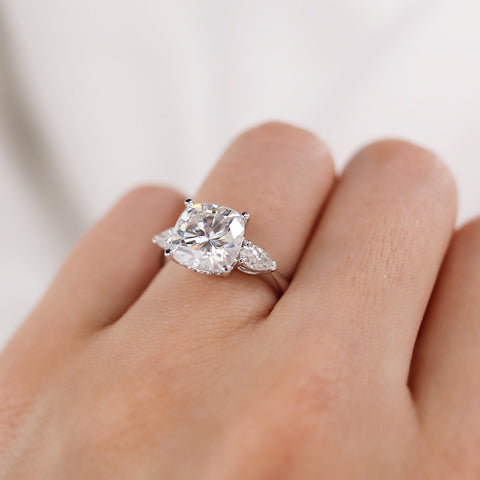Are Lab Grown Diamonds Real Diamonds?
Diamonds, the coveted gems adorning engagement rings, bracelets, and crowns, have long symbolised love, eternity, and beauty. However, the traditional narrative surrounding diamonds is undergoing a shift with the emergence of lab-grown diamonds. These engineered marvels pose a fascinating question: Are lab-grown diamonds real diamonds? Delving into their composition, ethics, and sustainability, we unravel the intricate tale of these dazzling gems and their natural counterparts.

The Essence of Diamonds: Composition Unveiled
To discern the authenticity of lab-grown diamonds, we must first explore their fundamental composition. At their core, diamonds consist of carbon atoms arranged in a crystal lattice structure, a configuration that bestows upon them unparalleled hardness and brilliance. This molecular arrangement is the defining characteristic of diamonds, whether formed within the depths of the Earth or cultivated within a controlled laboratory environment.
Lab-grown diamonds, crafted through high-pressure high-temperature (HPHT) or chemical vapour deposition (CVD) methods, replicate the natural processes responsible for diamond formation. In essence, both natural and lab-grown diamonds boast identical chemical compositions and crystal structures. This remarkable similarity underscores the inherent authenticity of lab-grown diamonds, affirming their status as bona fide gems!
In the realm of gemstones, the emergence of lab-grown diamonds has revolutionised the industry, offering a level of control over clarity and quality that surpasses natural diamonds. Lab-grown diamonds, cultivated through advanced technological processes, provide a host of advantages in terms of consistency, purity, and ethical sourcing.
First and foremost, the controlled environment in which lab-grown diamonds are produced allows for meticulous oversight of their growth process. Unlike natural diamonds, which form deep within the Earth's mantle under immense pressure and heat, lab-grown diamonds are created under controlled conditions in a laboratory setting. This controlled environment enables scientists to manipulate variables such as temperature, pressure, and chemical composition to precisely engineer diamonds with desired characteristics.
Furthermore, the predictability of lab-grown diamond creation ensures a higher degree of consistency in clarity and quality. In contrast to natural diamonds, which can vary widely in clarity due to natural inclusions and imperfections, lab-grown diamonds can be cultivated to meet specific standards of clarity and purity. Through precise control over the growth process, scientists can minimise or eliminate internal flaws, resulting in diamonds that exhibit exceptional clarity and brilliance.
Moreover, the ethical implications of lab-grown diamonds contribute to their appeal as a sustainable alternative to mined diamonds. Traditional diamond mining often raises concerns about environmental degradation, human rights abuses, and exploitative labour practices. In contrast, lab-grown diamonds require no mining and have a significantly lower environmental footprint. By choosing lab-grown diamonds, consumers can support more ethical and environmentally responsible practices within the jewellery industry.
Ethics and Sustainability: A Paradigm Shift
Beyond their chemical likeness, lab-grown diamonds present a compelling case for ethical and sustainable jewellery practices. Unlike their natural counterparts, which often necessitate environmentally disruptive mining operations, lab-grown diamonds are cultivated with minimal ecological footprint. By sidestepping the ecological toll of mining, these diamonds offer a more sustainable alternative, reducing land degradation, water pollution, and carbon emissions associated with traditional diamond extraction.
The ethical implications of lab-grown diamonds resonate deeply within an industry historically marred by concerns surrounding labour practices and human rights violations. The diamond mining sector has, regrettably, been associated with instances of exploitation, child labour, and conflict financing. In stark contrast, lab-grown diamonds provide a transparent and ethically sound supply chain, free from the shadow of exploitation and coercion.
In today's jewellery market, the ease of tracking the origins of lab-grown diamonds provides consumers with assurance regarding ethical practices throughout the supply chain. Unlike natural diamonds whose journey from mine to market can be obscured by complex networks of suppliers, the production process of lab-grown diamonds offers transparency and traceability.
Lab-grown diamonds are typically created in controlled environments within specialised facilities, allowing for meticulous documentation of each diamond's origin and production history. Manufacturers of lab-grown diamonds maintain detailed records that track the entire growth process, including the precise conditions under which each diamond was cultivated.
Advancements in technology, such as blockchain and digital certification platforms, facilitate the transparent tracking of lab-grown diamonds from production to purchase. These technologies enable consumers to access comprehensive information about the origin, characteristics, and ethical practices associated with each diamond.
By leveraging these tracking mechanisms, consumers can make informed decisions and support ethical practices within the jewellery industry. The ability to verify the ethical sourcing of lab-grown diamonds not only promotes transparency but also fosters accountability among manufacturers and retailers.

The Traditional Market: Cost of Lab Grown Diamonds
The rise of lab-grown diamonds has significantly impacted the traditional diamond market, influencing both consumer preferences and the pricing dynamics of natural diamonds. As lab-grown diamonds become increasingly accessible and accepted within the jewellery industry, their emergence has introduced a notable shift in the market landscape.
One of the most notable effects of the rise of lab-grown diamonds is increased competition within the diamond market. With lab-grown diamonds offering a more affordable alternative to natural diamonds, consumers now have greater choice and flexibility when selecting their desired gemstones. This expanded choice has prompted traditional diamond retailers to adapt their strategies to remain competitive in a changing market environment.
The growing popularity of lab-grown diamonds has exerted downward pressure on the prices of natural diamonds, particularly in certain market segments. As consumers become more aware of the ethical and environmental benefits of lab-grown diamonds, demand for natural diamonds may experience moderation, leading to adjustments in pricing dynamics.
However, it is important to note that natural diamonds still retain their intrinsic value and allure, particularly for consumers seeking rarity and tradition. While lab-grown diamonds offer many advantages, including ethical sourcing and consistency in quality, natural diamonds possess a timeless appeal that resonates with certain segments of the market.
The impact of lab-grown diamonds on the pricing of natural diamonds varies across different market segments and geographic regions. In some cases, the pricing differentials between lab-grown and natural diamonds have narrowed, reflecting changing consumer preferences and market dynamics. However, natural diamonds continue to command premium prices in certain luxury markets and for rare, high-quality specimens.
Overall, the rise of lab-grown diamonds has brought about significant changes to the diamond market, influencing consumer behaviour and pricing dynamics. While the increased availability of lab-grown diamonds has introduced greater competition and price sensitivity, natural diamonds continue to hold a special place in the hearts of consumers worldwide, embodying timeless beauty and enduring value. As the market continues to evolve, both lab-grown and natural diamonds will coexist, offering consumers a diverse array of options to suit their preferences and values.
A Comparative Analysis: Lab-Grown vs. Natural Diamonds
Environmental Impact
Natural diamond mining exacts a heavy toll on fragile ecosystems, disrupting landscapes, and depleting natural resources. The process entails massive energy consumption, extensive water usage, and habitat destruction, perpetuating environmental degradation on a significant scale. In contrast, lab-grown diamonds require substantially lower energy inputs and generate minimal waste, offering a more ecologically responsible alternative.
Purity and Clarity
Lab-grown diamonds, cultivated under controlled conditions, exhibit exceptional purity and clarity, devoid of the impurities and inclusions commonly found in natural diamonds. This pristine quality not only enhances their aesthetic appeal but also ensures consistency and uniformity across the entire diamond production process.
Cost and Accessibility
Traditionally, natural diamonds have commanded premium prices commensurate with their scarcity and perceived value. However, the advent of lab-grown diamonds has democratised access to these exquisite gems, offering consumers a more affordable yet equally dazzling alternative. This accessibility empowers individuals to make conscientious choices without compromising on quality or beauty.
Social Responsibility
The ethical dimensions of diamond sourcing extend beyond environmental considerations to encompass social responsibility and human rights. Lab-grown diamonds, produced in controlled laboratory settings, uphold stringent labour standards and transparency protocols, safeguarding the welfare of workers and communities involved in the diamond supply chain. This commitment to social responsibility distinguishes lab-grown diamonds as a beacon of ethical integrity within the jewellery industry.
Embracing the Future: The Rise of Lab Grown Diamonds
As consumer awareness burgeons and sustainability takes centre stage, the allure of lab-grown diamonds continues to proliferate. Their ethical provenance, environmental sustainability, and indistinguishable quality from natural diamonds position them as a compelling choice for conscientious consumers seeking beauty with a conscience.
In the ever-evolving landscape of fine jewellery, lab-grown diamonds exemplify innovation, integrity, and inclusivity. By challenging conventional norms and redefining the essence of luxury, these gems herald a new era of responsible elegance, where beauty resonates with purpose and authenticity.
The question of whether lab-grown diamonds are real diamonds transcends mere semantics, delving into the heart of authenticity, ethics, and sustainability. As we navigate the complexities of a rapidly changing world, lab-grown diamonds emerge not only as real diamonds but also as shining examples of progress and possibility in an industry poised for transformation.

Personal Preference
In conclusion, when it comes to choosing between lab-grown diamonds and natural diamonds, the decision ultimately boils down to personal preference and values. While both options offer their own distinct advantages and characteristics, it's essential to recognise that in terms of composition, lab-grown diamonds are unequivocally real.
The debate between lab-grown and natural diamonds often centres around factors such as cost, environmental impact, and ethical considerations. Lab-grown diamonds, cultivated through advanced technological processes, offer consumers a sustainable and ethical alternative to mined diamonds. They are created under controlled conditions in laboratories, allowing for precise control over factors like clarity and quality.
It's important to emphasise that lab-grown diamonds possess the same physical and chemical properties as natural diamonds. Both are composed of carbon atoms arranged in a crystalline structure, giving them their characteristic brilliance and hardness. In essence, lab-grown diamonds are indistinguishable from their natural counterparts in terms of composition and optical properties.
Ultimately, the choice between lab-grown and natural diamonds hinges on individual preferences, priorities, and values. Some may prioritise sustainability and ethical sourcing, opting for lab-grown diamonds as a conscious choice. Others may be drawn to the mystique and symbolism of natural diamonds, embracing their timeless elegance and rarity.
In the end, whether one chooses lab-grown or natural diamonds, the beauty and significance of the diamond remain unchanged. Both options offer unique benefits and serve as enduring symbols of love, commitment, and celebration. As consumers navigate the diamond market, understanding the distinctions between lab-grown and natural diamonds empowers them to make informed decisions that align with their personal values and preferences.
